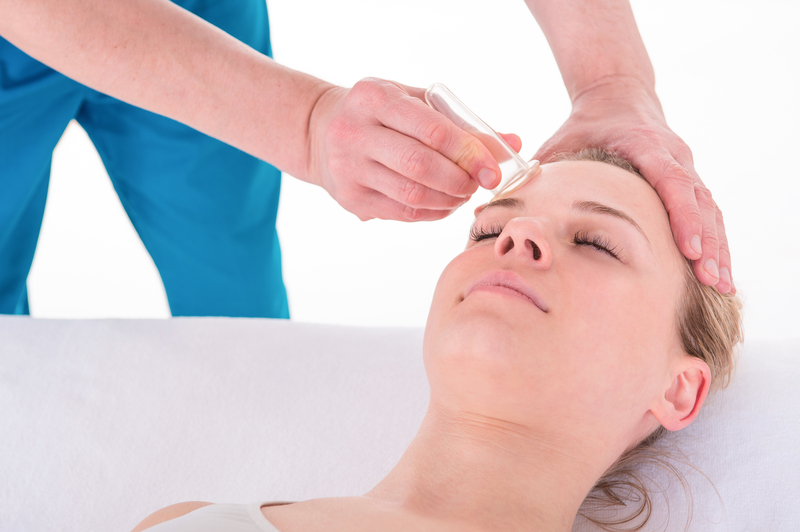Cupping Therapy

Cupping, also known as myofascial decompression, is a traditional Asian medical technique. Cupping therapy in traditional Chinese Medicine is created by placing silicone, glass, or plastic jars on the surface of the body to create a vacuum. After the air is removed (by either, pressure, air pump, or fire), the cups create suction and are placed over the area of pain or muscle tension. In ancient time bamboo was used to create suction for therapy.
The vacuum created by suction cups reduces pain and releases tension, increases energy and blood circulation and releases tight muscle tissue. Other popular applications of cupping therapy is facial rejuvenation as it increases circulation and lessens redness and tiny veins thus improving ones complexion. Likewise, by increasing circulation in the areas where cups are placed suction cups can be beneficial for digestive regulation and respiratory health.

Cupping therapy often produces circular marks from strong suction that brings blood and toxins to the skin surface thus promoting Blood and Qi circulation and reducing pain and muscle tightness. The marks left by cupping look like bruises; but unlike a bruise which is caused by a contusion, the dark marks from cupping are made by the cellular waste, or dead cells, pulled to the surface of the skin. The darker the marks, the more toxins are being released. Marks last for a few hours to a few weeks before fading. Cupping supports healthy cellular detoxification and healthy circulation of Qi by encouraging the removal of waste and improving microcirculation and the manufacture of blood cells.
Suction cupping increases blood flow and manually breaks up fascial adhesions. By creating more space between muscle, fascia, and bone, the range of motion is improved and pain is reduced. Old stagnant blood is flushed out of the tissue and fresh new blood infuses the area to promote faster recovery and healing. Cupping moves stagnant blood which will be eliminated by the body through lymphatic circulation and other organs of elimination.
In traditional Chinese medicine, Blood Stagnation is a condition that can lead to pain and swelling. In reality, the translation of Chinese medical term “Blood Stagnation” is inaccurate; the actual translation is something closer to “blood silt”. This suggests that there are toxins in the blood, or cellular waste in the blood that blocks the free flow of blood circulation.
Cupping marks serve as an evaluation tool and help to indicate the severity of blood stagnation. Generally, cups are left for 10-15 minutes and should not be so tight as to cause discomfort. Redness indicates heat; black indicates strong blood stagnation, or old blood (i.e. chronic blood stagnation). Purple indicates moderate blood stagnation. Blisters demonstrate toxins and "Dampness" in the tissue. If there is no change in the skin color, then the condition is caused by energy Qi stagnation and not Blood Stagnation typically.
![]()
Cupping for Exterior Pathogens
For Exterior Wind conditions, such as viral infections, cups are often placed along the neck and shoulder area to help release the Wind and prevent it from penetrating deeper in to the body where it may cause severe chronic disease and injury to Organ Systems.
Fire Cupping
The type of cupping typically used by licensed acupuncturists is called "Fire Cupping"; this is because cotton balls are doused in alcohol, ignited, and inserted into glass cups to produce suction. Fire cupping has been used for thousands of years. In ancient times they used animal horns and bamboo cups.
Cautions and Contraindications of Suction Cupping Therapy
- Injury due to burns or cuts are possible with Fire Cupping and should only be performed by a health professional certified in Fire Cupping.
- Avoid cupping in cases of high fever, convulsions, or edema.
- Do not use suction cupping over bone fractures, and/or sites of deep vein thrombosis, or dislocated joints.
- Do not cup over broken skin, tumors, or ulcers.
- Pregnant women should only receive cupping from a licensed health care professional; areas on the abdomen and sacral locations are not allowed in pregnancy.
![]()
Aboushanab TS, AlSanad S. Cupping Therapy: An Overview from a Modern Medicine Perspective. J Acupuncture Meridian Study. 2018 Jun;11(3):83-87. doi: 10.1016/j.jams.2018.02.001. Epub 2018 Feb 7.
Guo Yang, Chen Bo, Wang Dong-qiang. Cupping regulates local immunomodulation to activate neuralendocrine-immune worknet. Compl Ther Clin Pract. 2017;28:1–3.
Zhongguo Zhen Jiu. Effect of moving cupping on the immune function of red blood cells. 1999;19:367–368. 6.
Mahdavi Vaez, Reza Mohammad. A Compendium of Essays on Alternative Therapy. Publishing Press Manager IvonaLovric; 2012. Evaluation of the effects of traditional cupping on the biochemical, hematological and immunological factors of human venous blood. Review paper; pp. 67–88.
XiandaiKangfu. Ye L.H. Effect of cupping on human body immune function. 1998;23:1109–1121. 10.
This information has not been evaluated by the Food and Drug Administration. This information is not intended to diagnose, treat, cure, or prevent any disease.
